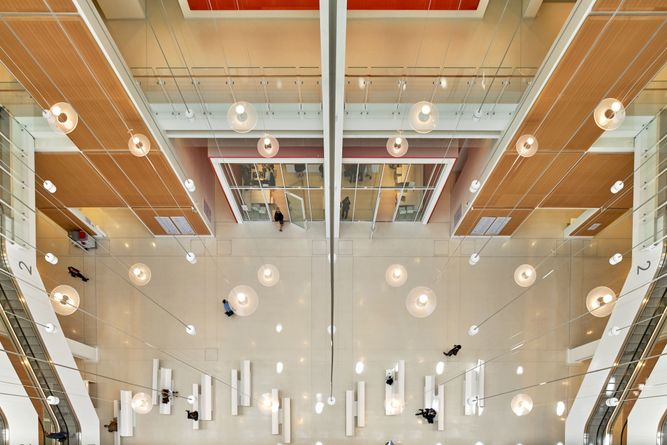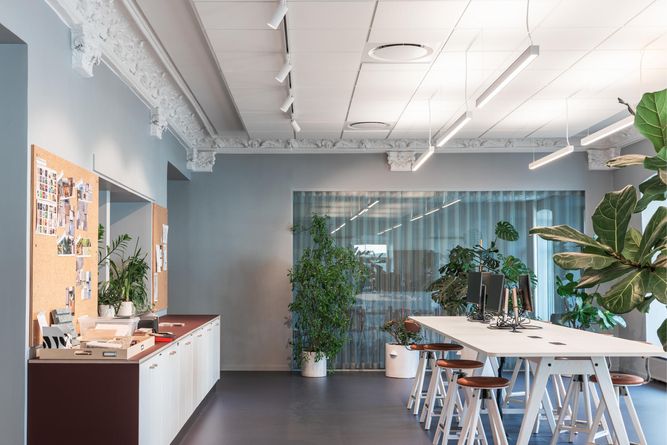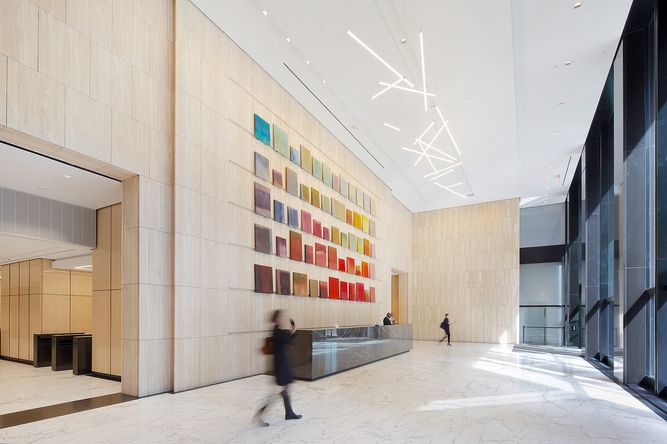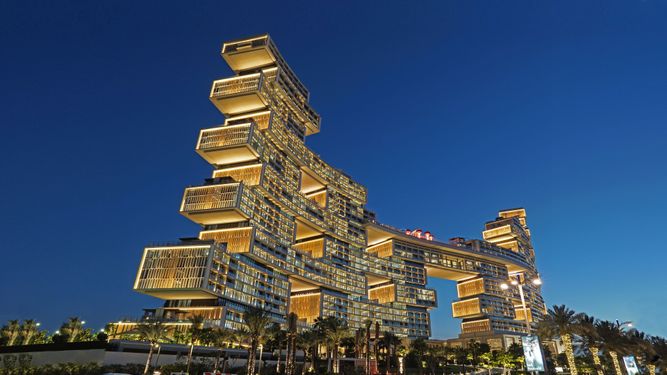7 reasons for smart lighting
Lighting that responds to its users, turns on when you are actually there, adopts to the daylight conditions and even identifies its own maintenance needs? It might once have felt like a luxury, but the benefits of smart lighting include better health, more efficiency, lower costs and environmental wins too.
In fact, it’s not just a nice-to-have – it’s an imperative for any business, real estate company, municipality or city looking to futureproof their premises, meet sustainability targets and integrate with other systems to offer new services to tenants and citizens.
Healthier living
Light has a profound impact on our health and wellbeing – and we spend about 90% of our lives indoors. That’s why the right lighting environment not only makes the office more attractive – it also contributes to the wellbeing of employees. And healthy, happy employees do better work.
In fact, a World Building Council study found that worker productivity increased 23% with enhanced lighting – as well as highlighting cost savings through lower staff turnover or absenteeism and improved attitudes towards employee health and wellbeing.
Human-led design allows lighting to mimic daylight throughout the day, changing intensity and color temperature. This affects the physical and emotional health and wellbeing of people working in the building. With the correct lighting, we are able to control the production of the sleep hormone melatonin and the stress hormone cortisol.
But every worker is an individual, and personal needs vary depending on the task, their age, and other factors.
That’s where our truly smart lighting solution will pay dividends, not only allowing you to control the lighting in the building to mimic the daylight, but also empowering the people in the building to adjust the lighting in their workspace to their preferences and needs. Personal lighting can easily be controlled with an app via your phone or other convenient means like voice control.
It’s not only office lighting that affects health and wellbeing. Getting the lighting
right outdoors – including streets, parking, and walkways – is essential to create a feeling of personal safety and comfort. That doesn’t mean having the waste and pollution of permanent lighting. Adaptive light-level solutions mean the light level can be dimmed to a minimum, or to warmer light temperatures, when it’s not needed – for example when no one is using the area. Not only does this limit light pollution but also helps with biodiversity in rural areas – where for example rows of light can be seen as barriers by larger animals, constricting their habitat.

ROI Takeaway: By improving the health, wellbeing and safety of employees, not only can productivity be improved but savings can be made on staff recruitment and retention.

ROI Takeaway: LED enabled smart lighting solutions can lower the energy consumption by up to 90%. This is key to achieve sustainability targets but also reduces lighting costs all year round.
Waste less energy
Traditionally, lighting systems are designed and deployed, then left to run over time without adapting to the changing environments or requirements.
With a smart lighting solution, you’re not stuck with the settings you buy. It is possible to improve energy efficiency over time based on actual usage and behaviour data. For example, we can override the default settings to dim the lights when daylight conditions are bright, achieving further energy savings.
Connected lighting solutions that are energy effective are crucial to reducing energy consumption. Analysis from Fagerhult Group shows that close to 90% of the emissions from our products comes from them being used, with just 8% of emissions attributed to materials.
Outdoors, too, it is easy to save energy on streetlights, including LED luminaires. Dimming the light level when streets are empty, and only bringing full lighting up when a presence has been detected, can result in energy savings of up to 80% compared to full light levels from dusk to dawn. And LEDs last longer when operated at low power or for less time.
For forward-thinking companies that want to achieve sustainable growth and
meet regulatory targets, a smart lighting solution is essential. It allows the
installation owner to dynamically change the parameters, dictating the light
levels and minimising wasted energy. That not only has a significant impact on
energy bills but will contribute to reducing the carbon footprint too.
Become circular
As recycling and sustainable practices become ever more important, smart lighting solutions and luminaires are an important part of the path to a circular business model.
Incorporating smart technology not only makes a difference right away but facilitates future circular practices too. Why? Because a smart lighting solution keeps you informed of the need for repairs or replacements, it reduces the price of your service costs as it allows you to plan maintenance well ahead.
And because smart lighting solutions enable luminaire usage to be tracked, warranties can reflect the actual usage of the luminaire based on burn time, as opposed to fixed time periods. This contributes to a longer lifetime of the lighting asset as realistic warranties allow for the possibility of reusing of the luminaire.

ROI Takeaway: By keeping the owner informed of the condition of luminaires, lighting fixtures can last longer or even be reused, saving money and reducing waste.

ROI Takeaway:Smart lighting offers the opportunity to reduce complexity and simplify operations creating efficiencies that reduce the workload for facilities, IT and maintenance. Using standardised APIs, and sharing data with the building’s other applications, smart lighting can drive efficiencies across a whole building system, not just lighting.
Open granular infrastructure
Lighting doesn’t exist in a silo, and with a smart lighting solution you can think
more holistically about the services in a building.
With smart lighting you can build a granular network of sensors throughout
the building, and with an open architecture it can be utilised by other buildings’
applications. For example, the system’s information and data on presence can
support indoor navigation or trigger activation of the heating, ventilation and
air conditioning (HVAC) systems at the right time. The result is a lower carbon
footprint, less energy waste, and less maintenance.
Smart lighting offers the opportunity for an open and collaborative approach to building services. Solutions are being developed and data models invented to ensure seamless interaction between systems, with Independent Data Layers (Middleware) used to incorporate data from multiple proprietary systems. The use of APIs (Application Programming Interfaces) enables flexibility as connections can be formed remotely without access to the site and deployed at any stage as needs and services develop over time.
Value added services
Smart lighting solutions provide opportunities to add on services enhancing the user experience and creating valuable insights. Employees and residents can be served with more innovative and attractive built environments, whether it’s an office building or outdoor city space.
For example, through a smartphone app, employees in a building are able to easily find and book a free workplace or meeting room or control the light over their workplace according to their own preferences.
Time and money can be saved by monitoring which spaces have been used, for example by mapping the areas that need cleaning or even closing down spaces that are used less during certain business hours.
On a grander scale, in an outdoor environment the city can engage with trusted external stakeholders to support events and incidents using the lighting infrastructure. For example, a ‘leading light’ can be created to guide a crowd to or from a venue or away from an emergency area. And light temperature and intensity can be adjusted in an area to create the right atmosphere for a special event such as a concert or a fair.
Through standardised APIs and structured data models, this will also allow
independent companies to simply and securely deploy off-the-shelf applications or alternatively to design the specific applications an installation owner may require.

ROI Takeaway: A survey conducted by Commercial Real Estate Services showed that EMEA occupiers are prepared to pay a rental premium of over 20% for tech-enabled smart buildings as it helps them attract and retain the best staff.

ROI Takeaway: Using remote connections, smart lighting can be controlled faster, more efficiently, and more effectively, without the need to be on site. For example, The Mitie building in London uses automated alarms, remote equipment management, machine learning, and data analytics to achieve a 95% accuracy rate for predictive maintenance calls and a 3% improvement in energy use by clients.
Securely managed
Smart lighting solutions can be accessed remotely through the IP network, allowing configuration, optimisation and status monitoring to be managed with no need to attend the site.
The owner can, at any time, oversee the entire installation and receive fault or error information to plan the system’s maintenance efficiently. The automation of previously manual building management tasks also extends to mandated tests such as monthly or annual emergency light testing.
The lighting solution can be reconfigured remotely without any physical intervention at the building site, reducing the time and cost relating to upgrading a site, minising downtime and ensuring the latest software is always running. But being connected is about more than remote configuration and monitoring. A wellarchitected, connected solution enables critical infrastructure to be located in the cloud without jeopardising system performance. Among its many benefits, cloudbased infrastructure enables a centralised approach to security where the latest technology can be constantly applied with the support of enterprise partners.
Flexible future
The needs of building tenants are constantly evolving with organisational changes and new user patterns. Most recently, companies have found they need to offer a work environment with more choices for their employees, following the post-pandemic move to working more from home. Getting the office environment right is proving to be an important retention and recruitment factor.
Smart lighting simply works ‘out of the box’, with little or no adjustment needed. Through the flexibility of a wireless solution, it’s possible to change configurations according to new floor plans without having to do any costly rewiring.
In an outdoor environment, the lighting needs may change according to road
conditions or weather conditions. For example, the light can be turned on earlier in the afternoon or turned off later in the morning if weather conditions demand it. Events such as thunderstorms with very dark clouds and heavy rain could trigger the light to stay on.
Smart lighting give users and real estate owners greater flexibility to adapt the system to changing needs. The secure open network and ease of remote access minimises the cost and complexity to make adjustments in future such as adding on new innovative services as they become available. The flexibility that comes with a smart lighting solution will support building strategies now and in the future.

ROI Takeaway: Smart lighting allows for greater flexibility in the future. With the ability to adapt the system simply and easily to a building’s evolving needs, reducing the time and cost of future fitting and upgrades.
Get started on smart lighting
Questions to ask about smart lighting:
1. Who do you turn to for smart lighting advise?
2. How can smart lighting support your sustainability agenda?
3. What value could smart lighting bring your business?
4. How can your building asset take advantage of smart lighting information?






